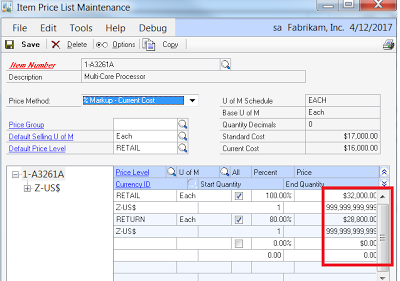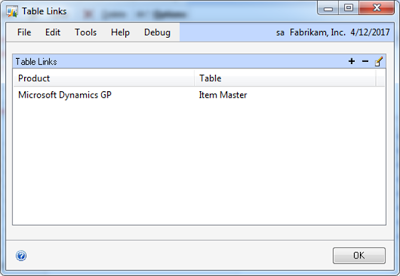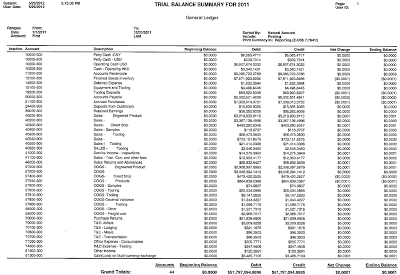Mark Polino's Blog, page 227
June 4, 2012
An Inside Look with Jay Manley - Inside Microsoft Dynamics GP - Site Home - MSDN Blogs
Published on June 04, 2012 10:00
Scrolling window obscures data of the last character | Dynamics University
At Dynamics University, Sheila Ochoa offers a solution for Scrolling window obscures data of the last character



















Published on June 04, 2012 09:00
Reporting on Microsoft Forecaster Data in Management Reporter - Dynamics Corporate Performance Management - Site Home - MSDN Blogs
April Olson covers Reporting on Microsoft Forecaster Data in Management Reporter at Dynamics Corporate Performance Management.
















Published on June 04, 2012 08:00
Table Links in Extender - Microsoft Dynamics GP Support Blog - Site Home - MSDN Blogs
Published on June 04, 2012 07:00
When It Comes to Dynamics GP 2013, a “Like Father, Like Son” Approach
This is a guest post from Glenn McPeak.
Coming
off of the Microsoft Dynamics GP 2013 sessions at Convergence, and anticipating
the GP technical Airlift event in September, I’m with all the other GP
professionals anxiously awaiting the expected product launch in
December 2012.
One of Microsoft's key goals
with this release is to position GP as a more competitive and flexible ERP
solution for the SMB market. For these organizations, hopefully GP 2013
will transform their business practices by building a strong foundation that
supports growth, increasing operational efficiencies and significantly lowering
the burden on IT. But for organizations looking to implement GP 2013, it’s
important to not only look at the new web client release and the other
150+ features, but also the other opportunities that come along with a new ERP
platform implementation.
A critical step during any ERP
implementation is to ask the question, “Do my ISV solutions align with
Microsoft’s own strategy with the ERP?” I sometimes refer to it as the “like
father, like son” approach. If the two solutions don’t align
strategically, then I encourage you to take a look at other technology options,
for both short and long-term success. When it comes to EDI for
Dynamics GP specifically, it’s 100% possible to integrate a solution that
aligns with Microsoft’s strategy – a “like father, like son” scenario that: 1) scales
to support business expansion, 2) increases processes efficiencies and 3)
eliminates unnecessary IT hassles.
To
achieve this synergy between solutions, whether evaluating your current EDI
technology or considering EDI integration at the time of ERP implementation,
it’s critical to understand the most frequent approaches to EDI and their
impact on your business:
Customization
– the client / partner develops a one-off, non-commercial solution
utilizing a set of tools and custom ERP code.
Result: Reliance on a tool set, not an all-in-one solution¸ which
creates long-term compatibility and upgrade pitfalls, and challenges
scalability to support business expansion.
Web-based
application – accessible via Internet connectivity and typically requires
a lower initial investment than other technology models.
Result: Often requires
manual data entry using web-forms and/or websites to make EDI work
end-to-end. Long term cost of ownership
can be extreme when factoring in transaction fees, manual entry labor and
errors resulting from the duplicate keying of information.
Commercial
ISV solution built inside Dynamics – solution is built with full
integration inside Microsoft Dynamics GP.
Result: GP platform
integrity is jeopardized by database and code changes to accommodate each and
every EDI request. Compliance mandates
and new partner integration can force unplanned customization and/or GP version
upgrades which can disrupt ERP activities, delay new business relationships and
trigger potentially costly fines.
ISV solution leverages
the native integration framework of the ERP platform while providing all
of the EDI transaction functionality outside the application
Result: Eliminates unnecessary ERP
customizations to enable EDI integration and compliance while simplifying daily
use and ERP update/upgrade projects.
The
first three approaches have their obvious challenges, especially the
customization of Dynamics GP. Applying service packs and version upgrades will
be a challenge plus, the addition of other necessary solutions can be
compromised. Only the fourth option – an
ISV solution built outside Microsoft Dynamics - aligns with Microsoft’s
strategic focus in releasing GP 2013 as a more agile platform to drive real
value into your business execution.
Some
business challenges are truly opportunities to help improve your company’s
competitiveness. Integrated EDI is a
perfect example – taking something that could be a daunting question mark and
turning it into a huge labor and cost saving win! By selecting a well-architected solution that
tightly integrates your business relationship transactions without customization
– you can be a big winner. The long-term
relationship between your ERP and EDI solution will only thrive if you walk in
your “father’s” shoes and embrace the strategic value proposition to which
Microsoft has committed themselves with GP 2013.








Coming
off of the Microsoft Dynamics GP 2013 sessions at Convergence, and anticipating
the GP technical Airlift event in September, I’m with all the other GP
professionals anxiously awaiting the expected product launch in
December 2012.
One of Microsoft's key goals
with this release is to position GP as a more competitive and flexible ERP
solution for the SMB market. For these organizations, hopefully GP 2013
will transform their business practices by building a strong foundation that
supports growth, increasing operational efficiencies and significantly lowering
the burden on IT. But for organizations looking to implement GP 2013, it’s
important to not only look at the new web client release and the other
150+ features, but also the other opportunities that come along with a new ERP
platform implementation.
A critical step during any ERP
implementation is to ask the question, “Do my ISV solutions align with
Microsoft’s own strategy with the ERP?” I sometimes refer to it as the “like
father, like son” approach. If the two solutions don’t align
strategically, then I encourage you to take a look at other technology options,
for both short and long-term success. When it comes to EDI for
Dynamics GP specifically, it’s 100% possible to integrate a solution that
aligns with Microsoft’s strategy – a “like father, like son” scenario that: 1) scales
to support business expansion, 2) increases processes efficiencies and 3)
eliminates unnecessary IT hassles.
To
achieve this synergy between solutions, whether evaluating your current EDI
technology or considering EDI integration at the time of ERP implementation,
it’s critical to understand the most frequent approaches to EDI and their
impact on your business:
Customization
– the client / partner develops a one-off, non-commercial solution
utilizing a set of tools and custom ERP code.
Result: Reliance on a tool set, not an all-in-one solution¸ which
creates long-term compatibility and upgrade pitfalls, and challenges
scalability to support business expansion.
Web-based
application – accessible via Internet connectivity and typically requires
a lower initial investment than other technology models.
Result: Often requires
manual data entry using web-forms and/or websites to make EDI work
end-to-end. Long term cost of ownership
can be extreme when factoring in transaction fees, manual entry labor and
errors resulting from the duplicate keying of information.
Commercial
ISV solution built inside Dynamics – solution is built with full
integration inside Microsoft Dynamics GP.
Result: GP platform
integrity is jeopardized by database and code changes to accommodate each and
every EDI request. Compliance mandates
and new partner integration can force unplanned customization and/or GP version
upgrades which can disrupt ERP activities, delay new business relationships and
trigger potentially costly fines.
ISV solution leverages
the native integration framework of the ERP platform while providing all
of the EDI transaction functionality outside the application
Result: Eliminates unnecessary ERP
customizations to enable EDI integration and compliance while simplifying daily
use and ERP update/upgrade projects.
The
first three approaches have their obvious challenges, especially the
customization of Dynamics GP. Applying service packs and version upgrades will
be a challenge plus, the addition of other necessary solutions can be
compromised. Only the fourth option – an
ISV solution built outside Microsoft Dynamics - aligns with Microsoft’s
strategic focus in releasing GP 2013 as a more agile platform to drive real
value into your business execution.
Some
business challenges are truly opportunities to help improve your company’s
competitiveness. Integrated EDI is a
perfect example – taking something that could be a daunting question mark and
turning it into a huge labor and cost saving win! By selecting a well-architected solution that
tightly integrates your business relationship transactions without customization
– you can be a big winner. The long-term
relationship between your ERP and EDI solution will only thrive if you walk in
your “father’s” shoes and embrace the strategic value proposition to which
Microsoft has committed themselves with GP 2013.








Published on June 04, 2012 06:30
June 3, 2012
The Dynamics GP Blogster: Year End Closing... NOT!
Published on June 03, 2012 16:51
Weekly Dynamic: GP 2010 R2 Excel Reports Deployment
The deployment of refreshable Excel Reports has been simplified with GP 2010 R2. The setup is still in Microsoft Dynamics GP - Tools - Setup - Reporting Tools Setup.
You can choose to deploy to a Network location, either a network share or Sharepoint, including Sharepoint online or you can deploy to a single user location.
As before, checkboxes exist to deploy reports for muliple company. The page is familiar but it has a much cleaner look.










You can choose to deploy to a Network location, either a network share or Sharepoint, including Sharepoint online or you can deploy to a single user location.
As before, checkboxes exist to deploy reports for muliple company. The page is familiar but it has a much cleaner look.









Published on June 03, 2012 15:00
June 1, 2012
Friday Fun - Cars
I have a MINI Cooper S and MINI just released some details about their newest performance version. The latest MINI Cooper John Cooper Works GP has been in the works for 2 years. It is a car designed for the track, but comfortable on the road turning in a Nürburgring laptime almost as fast as a 2010 Camaro SS and faster than at least one Porsche Cayman S. As a Dynamics GP lover and MINI lover few things warm my heart more than this hood scoop:



















Published on June 01, 2012 06:00
May 31, 2012
An Inside Look with Kurt Larson - Inside Microsoft Dynamics GP - Site Home - MSDN Blogs
Published on May 31, 2012 11:00
Microsoft Dynamics GP Addins DAG Utility - Developing for Dynamics GP
Published on May 31, 2012 10:00

























